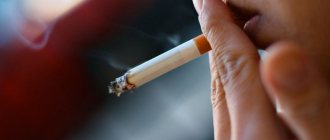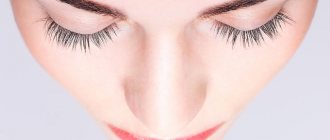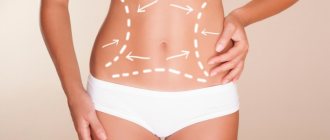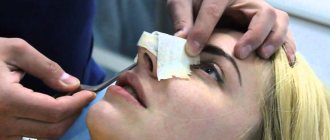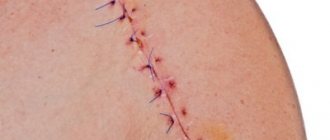Rhinoplasty is aimed at changing the shape of the nose or its size. This is one of the most popular operations in the field of plastic surgery today. But not everyone knows about what happens after it. Therefore, one of the most common questions is “Why did the tip sag after rhinoplasty?”
We will try to answer this question in detail, and also tell you what leads to this effect and how to deal with these factors. An aesthetically beautiful appearance can be restored if you do not make hasty conclusions and sudden movements.
Can the tip of the nose actually droop?
Yes, there is such a possibility. Moreover, quite a lot of patients report on forums that the tip of the nose can rise and fall and even take a different shape. What's the matter? After all, rhinoplasty is aimed at correcting defects. The drooping tip of the nose clearly does not fit into the idea of a “well-performed operation.” We don’t panic and don’t fix the situation with our own hands, because it’s not like fixing a chair - it requires delicate work, and a specialized specialist. We recommend that if such a problem arises, you contact the surgeon who operated on you. If this is not possible, then find another qualified doctor in this profile. Often, the opinion of an outside specialist often helps to dispel the doubts of many patients.
After the operation, the tip of the nose can “walk” for about another year and a half. This is explained by the fact that complete restoration, healing and shrinkage of the new form requires an impressive period of time. For the first couple of months, the surgical area will be swollen. Therefore, the tip will seem a little upturned. As the swelling subsides, the tip will also drop (by 3 mm on average over 6 months), and the nose itself will become sleeker and thinner. If the result is completely disappointing, then one of the following reasons is possible:
- When the primary and then secondary swelling subsides, the tip of the nose can drop down to 5 mm. Moreover, this will not necessarily be a defect after the intervention of a surgeon. These are completely natural processes of the body.
- If there was an open rhinoplasty, then dissection of the columella or excision of some part of it much more often leads to drooping of the nose.
- Complex operations, during which significant portions of bone, cartilage and soft tissue are excised, are much more likely to lead to drooping or even sagging of the tip of the nose. This often happens during operations involving complex deformities, injuries, or other unusual cases.
- Age also plays a huge role in this matter. In minors and patients abroad, no guaranteed results can be expected after 45 years. Moreover, the most unforeseen consequences of rhinoplasty may arise. Doctors associate these factors with the special structure of tissues with an unstable or depressed state. In such cases, the ability to regenerate can give any result.
- Removing a hump can also only visually lower the tip of the nose. But in reality it will be in the same place.
- It should not be ruled out that this was a planned result aimed at getting rid of snub nose.
- Gender also plays a role. Rhinoplasty in men is easier, and the consequences are rarely severe.
- We put the surgeon's mistake as the last point. This happens all the time, especially if the clinic and doctor were chosen hastily. What is most offensive in such a set of circumstances is that it is possible to correct what has been done, but at a higher cost (and much more) and only a year and a half after the last procedure.
So, as you can see, there are many reasons. But at first, as soon as you notice such a defect, you should contact the doctor who operated on you. Perhaps he can improve the situation in the right direction.
How long does rehabilitation last, and what does it depend on?
How long it takes for the operated nose to recover and the sutures to heal depends on the type of rhinoplasty.
If a complete rhinoplasty was performed with removal of the hump, then the recovery period will take about 10 days while wearing a special plaster splint in the shape of a butterfly on the nose. If the procedure for plastic surgery of the tip of the nose was performed, then rehabilitation will last a little less - 7 days with wearing the same splint. Splints, in turn, perform the function of an “assistant” in tissue fusion and restoration. From the inside, the shape of the nose is fixed using turundas inserted into the nasal passage, which absorb moisture and contribute to less swelling.
Such tampons are removed after 3-5 days, depending on the type of rhinoplasty . While noting these facts, you should not forget that the duration of healing, in addition to the main procedures, depends on compliance with the recommendations of your operating surgeon.
Full recovery after rhinoplasty occurs after 6-12 months.
This does not mean at all that the patient will walk around with swelling and yellow bruises for a whole year. Visible swelling and post-operative imperfections completely disappear within a month. The most difficult period occurs in the first three weeks, because... It is quite difficult for a person to get used to a number of restrictions associated with this procedure. Compliance with all rehabilitation rules will also help speed up the healing process.
We invite you to watch a video about how long it will take to recover after rhinoplasty:
How the recovery proceeds - description by day
First week
If in the first 2-3 days you have a fever, weakness, pain in the nose and nasopharynx, you should not worry. This is how the first week of recovery goes for almost every patient. In addition, the bandage, which should be worn for 7 days, also brings some discomfort .
Breathing at this time is done through the oral cavity due to the presence of tampons. During this period you should not:
- to go out;
- to be nervous;
- engage in any physical activity.
You have been prescribed bed rest. If your doctor has given recommendations for the use of any healing ointments, then they can be safely but carefully used for 2-3 days, immediately after removing the tampons.
7-14 days
During this period, the splints are removed. Swelling also noticeably decreases and bruises go away. After removing the plaster, the nasal passages must be washed and now, finally, the patient can breathe freely through the nose.
Now the patient can return to an active life, while not forgetting about the prohibition of serious exercise. Under no circumstances should you blow your nose. The patient should get used to sleeping on his back using a high pillow. You can treat the nostrils using a 3% solution of hydrogen peroxide and a cotton swab.
Up to a month
- Any mechanical procedures on the skin around or around the nose are prohibited.
- Don't forget about proper sleep.
- Under no circumstances should you wear glasses, because... they can harm unhealed tissues.
- Treatment occurs on the recommendation of a doctor.
- If the patient is bothered by pain, the doctor prescribes a painkiller.
A month or more
After a month after rhinoplasty, the nose begins to take on its shape. The main swelling goes away at this stage and the patient can see the approximate result of the operation.
At your appointment with the surgeon, you should take a photo to compare the results before and after. Photos can be taken at different stages if deemed necessary.
Plaster - how long to wear it?
The plaster is removed after a week . But you should not hope that after removing the plaster cast you will see the result. On the contrary, the plaster cast will no longer contain swelling; the nose will appear larger.
Swelling is not any abnormality and is a completely normal phenomenon at this stage of rehabilitation. After removing the plaster, be sure to take a photo.
Stitches - when and how they are removed, does it hurt?
On the mucous membrane, the sutures dissolve on their own. 2-3 weeks after the operation, the sutures on the skin are removed. Some seams require special care.
If the patient has any, the operating surgeon prescribes an ointment containing an antibiotic. However, if the sutures are placed correctly, no special care is required. The stitches are not painful to remove .
If you are about to undergo rhinoplasty surgery, we recommend that you read the special publications of our experts, after reading which you will learn:
- What can be the consequences of rhinoplasty and how to avoid an unsuccessful operation?
- What are the main stages of the procedure?
- What is non-surgical rhinoplasty, what are the pros and cons of performing the procedure using threads?
- How to fix your nose with a “potato”?
Is it possible to avoid nasal tip drooping?
It is worth understanding that drooping of the tip of the nose occurs literally in 100% of cases after the procedure. But to what level he will do this - each organism will decide individually when rhinoplasty is performed. Lower the tip of the nose or raise it - here friction and internal contradictions arise literally with oneself.
Fact! People with problematic, rough, thick skin are more likely to see the tip of their nose droop after surgery. This is also affected by the proliferation of connective tissue. These problems most often accompany open rhinoplasty.
Those patients who claim that after the operation the tip of their nose did not droop, got rid of swelling due to the characteristics of their own body even before the removal of the plaster. This means that we saw our new nose almost ready. But these are rather exceptions to the rule.
Consequences after rhinoplasty: Photo
Deviated septum
Bulges due to cartilage deformation Swelling and tissue hematomas
A separate stage is the restoration of the patient’s normal psychological state after unsuccessful rhinoplasty. Since it is mainly women who are in line for this operation, they are more susceptible to depression and dissatisfaction with their appearance. For women who plan to reduce the negative consequences to zero, laser rhinoplasty is recommended.
What to do?
If there are changes that cause concern, you are obliged to come to your surgeon and show them what worries you. If you have lost trust in a specialist, it is better to turn to another or even others from another clinic. This will allow you to look at the whole picture more objectively. But do not withhold information about the operation when it was performed and it is advisable to provide a medical record.
If other specialists have concluded that you have a clear nasal tip deformity, displacement, or other defect, then you can begin planning a new operation. When choosing a clinic, we strongly recommend that you pay attention to reviews from real people, which are found online only on third-party resources. Ideally, you should look for a good clinic and doctor through friends.
How to properly rinse your nose in the postoperative period
To avoid infection and other complications, it is necessary to rinse the nasal cavity once every 3-4 hours.
Aqualor sprays are used when the body is in an upright position. In this case, the head should be straight and slightly tilted forward. Be careful not to tilt your head back during use.
Immediately after washing, it is necessary to remove the crusts while they are softened. Do this carefully, using a cotton swab, never your finger.
The duration of irrigation therapy is determined by the attending physician. On average, it is 2-3 months.
